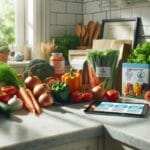How To Know If Food Contains Gluten? An Expert Guide for Shoppers and Families
Imagine this: You’re a parent at a bustling grocery store, scanning ingredient lists while your child tugs at your sleeve. Last week, after a pasta dinner, your child complained of stomach pain. Now, you’re determined to find out: how to know if food contains gluten? With confusing labels and hidden ingredients, it’s easy to feel overwhelmed. But with the right knowledge—and the right tools—you can shop with confidence and keep your family safe.
What Is Gluten and Why Does It Matter?
Gluten is a group of proteins found in wheat, barley, rye, and their derivatives. For people with celiac disease, gluten triggers an immune response that damages the small intestine. Others may have non-celiac gluten sensitivity or wheat allergy, causing symptoms like bloating, headaches, or rashes.1
- Celiac disease: Autoimmune disorder; strict gluten avoidance is necessary.
- Non-celiac gluten sensitivity: Symptoms without intestinal damage.
- Wheat allergy: Allergic reaction to wheat proteins, not just gluten.
Knowing whether food contains gluten is crucial for millions worldwide.
How to Know If Food Contains Gluten? Key Strategies
Let’s break down the most effective ways to identify gluten in your food—at home, in restaurants, and while shopping.
1. Read Ingredient Lists Carefully
Gluten can hide under many names. Here’s a quick-reference table for common gluten sources:
| Ingredient | Contains Gluten? | Notes |
|---|---|---|
| Wheat | Yes | Includes spelt, durum, semolina, farro |
| Barley | Yes | Often in malt, beer, flavorings |
| Rye | Yes | Bread, cereals |
| Oats | Maybe | Gluten-free if certified; risk of cross-contamination |
| Modified food starch | Maybe | Source varies—check label or ask manufacturer |
| Hydrolyzed vegetable protein | Maybe | Source may be wheat-based |
Tip: In the US, wheat must be clearly labeled as an allergen, but barley and rye do not have to be.2
2. Look for Gluten-Free Certification
- Products labeled “gluten-free” in the US must contain less than 20 parts per million (ppm) of gluten, per FDA regulations.
- In the EU, the threshold is also 20 ppm, regulated by the EFSA and local authorities.
- Look for trusted logos like the “Certified Gluten-Free” seal from organizations such as the Gluten Intolerance Group.
3. Use Technology: Food Scan Genius App
Food Scan Genius is a powerful app designed for people with food sensitivities, allergies, or dietary preferences. Simply scan a product’s barcode, and the app instantly tells you if it contains gluten or other allergens. It’s a game-changer for busy shoppers and families.
“I used to spend ages reading labels, but now I just scan with Food Scan Genius. It’s saved me from accidental gluten exposure more than once!”
– Sarah, mom of two, New York
Download Food Scan Genius here and make gluten detection effortless.
How Do US and EU Labeling Laws Differ?
Understanding regional differences is key for international shoppers and travelers.
United States (FDA)
- Wheat is one of the top 9 allergens and must be clearly listed on packaged foods.2
- Barley and rye are not required to be labeled as allergens.
- “Gluten-free” label is voluntary but regulated (must be <20 ppm gluten).
European Union (EFSA)
- All gluten-containing cereals (wheat, rye, barley, oats, spelt, kamut) must be bolded or highlighted in the ingredient list.3
- “Gluten-free” and “very low gluten” labels are standardized across EU countries.
- Allergen information must be provided for non-prepacked foods (e.g., bakery, restaurant).
Bottom line: EU labeling is generally stricter, but both regions require vigilance. Always check the label, and when in doubt, use a scanner app like Food Scan Genius.
Hidden Sources of Gluten: What to Watch For
Gluten isn’t just in bread and pasta. It can lurk in:
- Soups and sauces (thickened with wheat flour)
- Processed meats (sausages, deli meats)
- Salad dressings and marinades
- Snack foods (chips, crackers, cereal bars)
- Beer and malt beverages
- Vitamins and supplements (as binders)
For a comprehensive check, scan products with Food Scan Genius before you buy or consume them.
Dining Out: How to Know If Food Contains Gluten?
Eating at restaurants can be tricky, but these steps help:
- Ask direct questions: “Does this dish contain wheat, barley, or rye?”
- Request allergen menus: Many chains now provide detailed allergen information.
- Watch for cross-contact: Even gluten-free dishes can be contaminated if prepared near gluten-containing foods.
Some restaurants use QR codes or digital menus. Scan with Food Scan Genius to check for gluten instantly.
Q&A: How to Know If Food Contains Gluten? (For Voice Search & Featured Snippets)
Q: What foods always contain gluten?
A: Foods made from wheat, barley, or rye—such as bread, pasta, beer, and most baked goods—always contain gluten unless labeled gluten-free.
Q: Are oats gluten-free?
A: Pure oats are gluten-free, but they are often contaminated with wheat during processing. Only eat oats labeled “gluten-free.”4
Q: How accurate are gluten scanner apps?
A: Apps like Food Scan Genius use up-to-date databases and barcode scanning to identify gluten ingredients, but always double-check labels for safety.
Q: What should I do if I accidentally eat gluten?
A: If you have celiac disease or severe sensitivity, consult your doctor. Drink water, rest, and monitor symptoms. For mild reactions, symptoms usually resolve within a few days.5
Expert Tips for Gluten-Free Shopping
- Shop the perimeter: Fresh fruits, vegetables, meats, and dairy are naturally gluten-free.
- Choose certified gluten-free products: Look for official seals and certifications.
- Use technology: Food Scan Genius makes it easy to check products on the go.
- Stay informed: Follow news from trusted sources like The New York Times and CNN Health for updates on gluten-free labeling.
Conclusion: Take Control of Your Gluten-Free Journey
Remember our story at the start? That parent now knows exactly how to know if food contains gluten—by reading labels, understanding regulations, and using Food Scan Genius to scan any product. Whether you’re shopping in the US or EU, eating out, or cooking at home, knowledge and technology empower you to make safe, informed choices.
Ready to make gluten-free living easier? Download Food Scan Genius today and scan your way to peace of mind.
Frequently Asked Questions
- How do I know if a product contains gluten?
- Check the ingredient list for wheat, barley, rye, or their derivatives. Look for gluten-free certification or scan with Food Scan Genius for instant answers.
- Are gluten-free labels reliable?
- Yes, in the US and EU, gluten-free labels are regulated and indicate less than 20 ppm gluten.
- Can I trust restaurant menus?
- Always ask staff about gluten content and cross-contact. When possible, use apps or allergen menus for verification.





